
Viktor Elpidiforovich Borisov-Musatov stands as a pivotal figure in Russian art at the turn of the 20th century, a painter whose ethereal and melancholic canvases captured the wistful spirit of a fading era. His work, deeply imbued with Symbolist sensibilities and a unique Post-Impressionist technique, created a distinct artistic language that resonated with the "Silver Age" of Russian culture. Though his life was tragically short, his influence was profound, paving the way for a new generation of Russian avant-garde artists.
Early Life and Seeds of Melancholy
Viktor Borisov-Musatov was born on April 14 (April 2 O.S.), 1870, in Saratov, a provincial city on the Volga River. His father, Elpidifor Borisovich Musatov, was a former serf who had become a minor railway employee, and his mother was Arina Gavrilovna Musatova. The family name "Borisov-Musatov" was adopted by the artist later, combining his patronymic with his surname to distinguish himself.
A defining event of his childhood occurred at the age of three when he suffered a severe fall from a bench. This accident resulted in a spinal injury that led to the development of kyphosis, or a hunchback, a condition that would cause him lifelong physical suffering and undoubtedly contributed to the introspective and often melancholic mood of his art. Despite numerous attempts at treatment throughout his life, the deformity remained, shaping his physical presence and perhaps his psychological outlook. This early encounter with fragility and suffering may have sown the seeds for his later artistic preoccupation with themes of transience, memory, and idealized beauty.
His artistic inclinations emerged early. Growing up in Saratov, a city with a burgeoning cultural scene, provided some initial exposure to art. His grandfather was a notable figure, and the family, despite modest means, seemed to support his artistic pursuits.
Artistic Formation: Moscow, St. Petersburg, and Paris
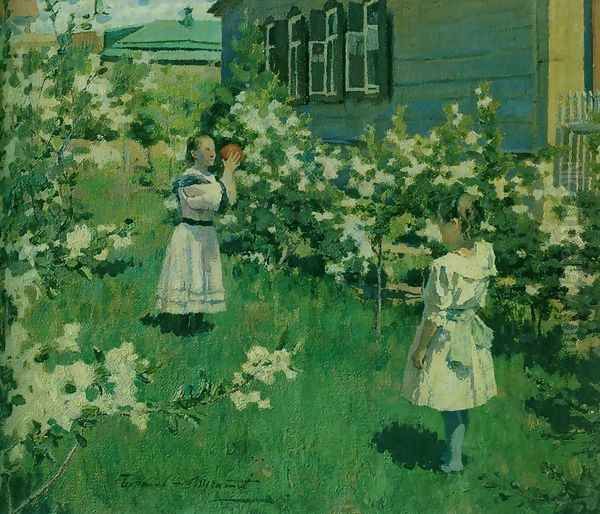
Borisov-Musatov's formal artistic education began in his native Saratov, where he likely attended local art circles. However, seeking more rigorous training, he moved to Moscow in 1890 and enrolled at the Moscow School of Painting, Sculpture, and Architecture. Here, he studied under influential artists such as Vasily Polenov, known for his lyrical landscapes and historical paintings, and Illarion Pryanishnikov, a prominent member of the Peredvizhniki (Wanderers) movement, which emphasized social realism.
While the Peredvizhniki dominated the Russian art scene with their focus on contemporary social issues and narrative realism, Borisov-Musatov found himself drawn to different artistic currents. He briefly attended the Imperial Academy of Arts in St. Petersburg in 1891, studying under the renowned Pavel Chistyakov, a teacher who emphasized rigorous draftsmanship and a deep understanding of form. However, the academic atmosphere of St. Petersburg did not entirely suit his temperament or artistic aspirations.
A crucial period in his development was his time spent in Paris, the epicenter of artistic innovation in the late 19th century. From 1895 to 1898, Borisov-Musatov immersed himself in the Parisian art world. He studied in the studio of Fernand Cormon, a popular academic painter whose atelier attracted many international students, including figures like Henri de Toulouse-Lautrec and Vincent van Gogh (though at different times).
More significantly, Paris exposed Borisov-Musatov to French Impressionism and Post-Impressionism. He was particularly captivated by the works of Pierre Puvis de Chavannes, whose serene, allegorical murals with their muted palettes and simplified forms profoundly influenced his sense of composition and mood. He also admired the delicate intimacy of Berthe Morisot's paintings and the broader innovations of Impressionists like Claude Monet and Pierre-Auguste Renoir, whose approaches to light and color were revolutionary. He reportedly tried to join Paul Gauguin's studio, but Gauguin was not accepting students at the time. The influence of Gauguin's Symbolism, with its emphasis on subjective experience and decorative patterning, can still be discerned in Musatov's later work. He also encountered the works of artists like Gustave Caillebotte, Edouard Manet, Alfred Sisley, and Georges Seurat, absorbing the diverse currents of modern French art.
This Parisian sojourn was transformative. It was here that he began to move away from the prevailing realism of his Russian training and towards a more personal, lyrical, and symbolic mode of expression. He developed a fascination with the Art Nouveau movement, with its emphasis on decorative qualities and organic forms, which would also find its way into his mature style.
The Emergence of a Unique Vision: Symbolism and Nostalgia
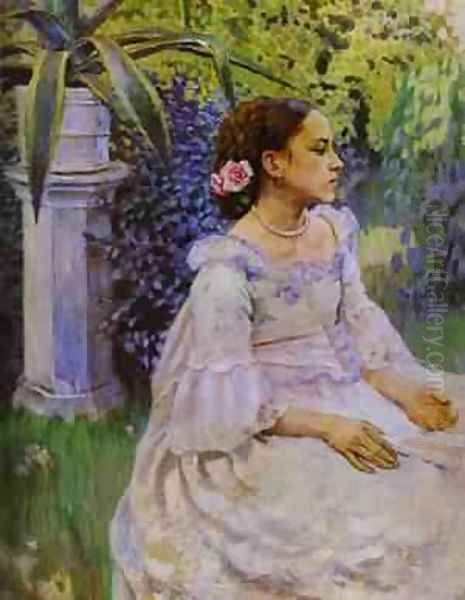
Upon his return to Russia in 1898, Borisov-Musatov settled for a time in Saratov, but his artistic vision was now firmly shaped by his European experiences, synthesized with a deeply Russian sensibility. He became a key figure in the burgeoning Russian Symbolist movement, which sought to express spiritual and emotional truths through evocative imagery, often drawing on myth, legend, and dreamlike states. Alongside Mikhail Vrubel, another towering figure of Russian Symbolism known for his dramatic and often demonic imagery, Borisov-Musatov is considered one of the founders and principal exponents of this style in Russia.
His art, however, possessed a distinct character. Unlike Vrubel's intensity, Borisov-Musatov's Symbolism was gentler, more elegiac, and imbued with a profound sense of nostalgia. He created a world of "nests of gentlefolk" – idyllic, old country estates populated by graceful, enigmatic women in period costumes, often from the early 19th century. These figures, seemingly lost in reverie, inhabit tranquil gardens, linger by quiet ponds, or gaze from verandas, evoking a sense of a bygone era, a "golden age" of Russian gentry that was rapidly disappearing.
His style was a unique fusion: the decorative principles of Art Nouveau, the atmospheric qualities of Impressionism (particularly in his handling of light and color), and the flat, frieze-like compositions reminiscent of Puvis de Chavannes, all filtered through a deeply personal, melancholic romanticism. He often employed a distinctive technique, using tempera, watercolor, and pastel on canvas, which lent his works a matte, fresco-like quality and a soft, shimmering texture. His color palettes were typically muted and harmonious, dominated by blues, greens, mauves, and grays, contributing to the dreamlike and poetic atmosphere of his paintings.
An early work, May Flowers (1894), created before his full stylistic maturation, was reportedly criticized by the school administration for being "immature." This indicates his early departure from academic norms and his search for a personal artistic language.
Masterpieces of a Fleeting World
Borisov-Musatov's mature period, though brief, produced a series of iconic works that encapsulate his artistic vision.
Self-Portrait with Sister (1898) is one of his most poignant early masterpieces. Painted shortly after his return from Paris, it depicts the artist and his beloved sister, Elena, in an intimate, contemplative moment. The figures are rendered with a delicate sensitivity, and the overall mood is one of quiet introspection. Elena often served as a model for the ethereal female figures in his paintings.
Agava (1897), painted during his Paris years, already shows his move towards a more decorative and symbolic style, with the exotic plant perhaps symbolizing an inner world or a distant ideal.
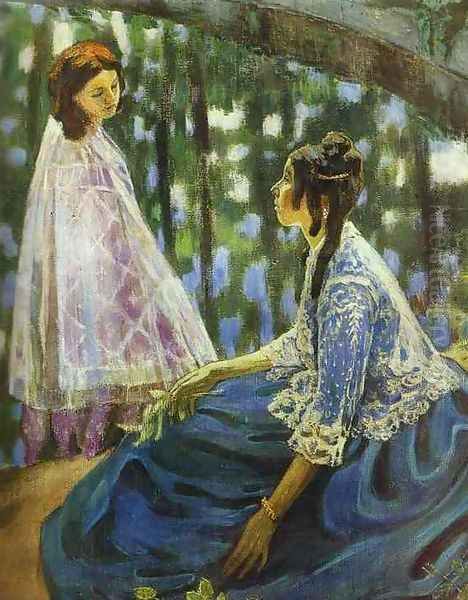
Perhaps his most famous work is The Pool (also known as The Pond or Vodoyom), painted in 1902. This large canvas depicts two women in 1840s attire by a serene, reflective pond on an old estate. The figures, believed to be his sister Elena and his future wife, the artist Elena Alexandrova (whom he married in 1903), are arranged in a harmonious, almost musical composition. The atmosphere is one of profound stillness and quiet melancholy, a perfect embodiment of the "Musatovian elegy." The painting is a quintessential example of Russian Symbolism, where the external scene serves as a mirror for an inner emotional landscape.
Phantoms (or Ghosts, Prizraki), completed in 1903, further explores these themes of memory and illusion. Ethereal female figures drift through the grounds of an old Zubrilovka estate, their forms almost dissolving into the misty landscape. The painting evokes a sense of dreams, fading memories, and the intangible presence of the past. The Zubrilovka estate, belonging to the Prozorovsky-Golitsyn princes, became a recurring motif in his work, a symbol of the vanishing aristocratic culture he so poetically lamented.
Another significant work from this period is Emerald Necklace (1903-1904), where richly dressed women are depicted in a lush, decorative garden setting, their figures almost woven into the tapestry of foliage and flowers. The title itself suggests a precious, jewel-like quality, reflecting his concern with beauty and aesthetic harmony.
His final major work, Requiem (1905), was painted as a tribute to his recently deceased friend Nadezhda Staniukovich. It is a more somber and overtly symbolic piece, depicting a procession of grieving figures in a stark, autumnal landscape. The painting reflects his own declining health and perhaps a premonition of his early death.
Technique and the "Music of Color"
Borisov-Musatov was a master of creating mood through color and texture. He often referred to his paintings as "music for the eyes," and indeed, his compositions have a lyrical, rhythmic quality. His preference for tempera, often combined with watercolor and pastel, allowed him to achieve a unique surface quality – matte, soft, and slightly granular, reminiscent of frescoes or tapestries. This technique avoided the glossy finish of oil paint, contributing to the ethereal, non-material quality of his imagery.
His brushwork was often delicate, sometimes employing a technique akin to a softened Pointillism, creating a "flimmering" or shimmering effect that made his figures and landscapes appear almost to vibrate with a gentle light. This careful application of color and attention to texture were integral to his aim of creating a harmonious and emotionally resonant visual experience, rather than a mere depiction of reality. He sought a "symphony of colors" that would evoke feelings and sensations beyond the literal subject matter.
Contemporaries and Artistic Circles
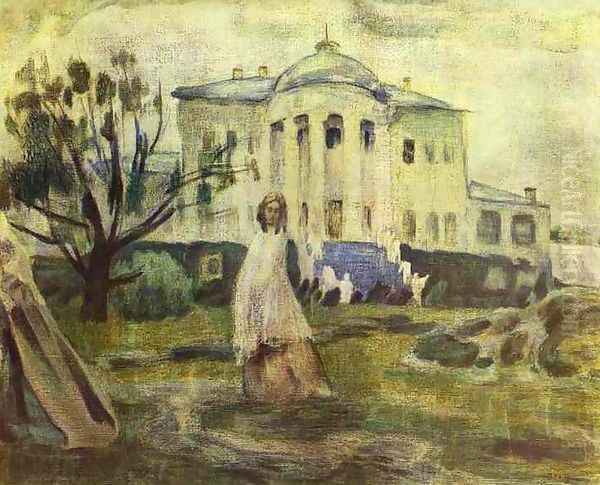
While Borisov-Musatov forged a highly individual path, he was part of a vibrant artistic milieu in Russia. He was a member of the Union of Russian Artists and participated in exhibitions of the Moscow Association of Artists. His work resonated with the aesthetics of the Mir Iskusstva (World of Art) movement, led by figures like Alexandre Benois and Sergei Diaghilev, which championed artistic individualism, aestheticism, and a revival of interest in 18th and early 19th-century art and culture. Though not a formal member, his art shared Mir Iskusstva's retrospective tendencies and its emphasis on refined craftsmanship and decorative beauty. Artists like Konstantin Somov and Léon Bakst, key figures in Mir Iskusstva, explored similar themes of historical nostalgia and refined elegance.
His influence was particularly strong on the younger generation of Symbolist painters, especially the artists of the Blue Rose (Golubaya Roza) group, which emerged shortly after his death. Painters such as Pavel Kuznetsov, Martiros Saryan, Sergei Sudeikin, and Nikolai Sapunov were deeply indebted to Borisov-Musatov's lyrical Symbolism, his evocative use of color, and his dreamlike imagery. They continued his exploration of subjective states and spiritual themes, albeit often with a more mystical or exotic inflection.
Other notable contemporaries whose work provides context include Valentin Serov, a brilliant portraitist who also experimented with Impressionistic techniques, and Isaak Levitan, the master of the "mood landscape," whose poetic depictions of Russian nature shared a certain lyrical sensibility with Musatov, though their styles differed. Mikhail Nesterov, another contemporary, explored themes of religious mysticism and spiritual yearning in his Symbolist-inflected paintings. The Savitsky brothers, Konstantin Savitsky (one of his early teachers) and Nikolay Savitsky, also played a role in the artistic environment, though their realist approach differed significantly from Musatov's mature style.
Despite his growing reputation among fellow artists and connoisseurs, Borisov-Musatov's work was not always understood or appreciated by the wider public or more conservative critics during his lifetime. Some found his art too decadent, overly idealized, or lacking in the social relevance championed by the Peredvizhniki. His early work May Flowers (1894) was even dismissed by school authorities as "immature," highlighting the resistance he sometimes faced.
Later Years, Tarusa, and Premature Death
In 1903, Borisov-Musatov married the artist Elena Vladimirovna Alexandrova, who had often modeled for him. Their shared artistic sensibilities created a strong bond. In 1904, their daughter Marianna was born.
Seeking a tranquil environment conducive to his work and health, Borisov-Musatov moved to Podolsk, near Moscow, and then, in the spring of 1905, to Tarusa, a picturesque town on the Oka River. Tarusa was a popular retreat for artists and writers, including the poet Marina Tsvetaeva, whose family had a dacha there. He hoped the peaceful surroundings and fresh air would benefit his deteriorating health.
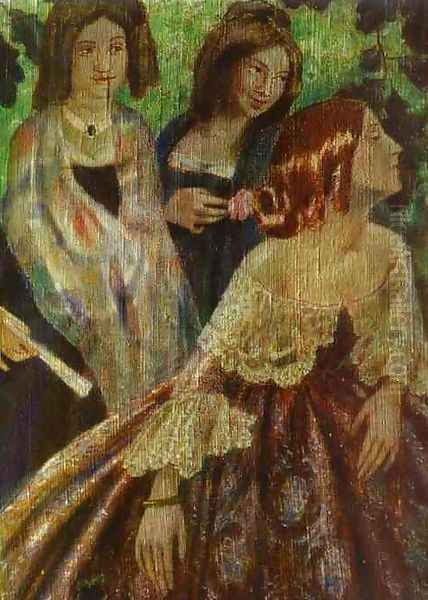
In Tarusa, he continued to paint, creating some beautiful landscapes and working on his Requiem. However, his physical condition worsened. His lifelong spinal problems were compounded by what was likely heart disease. On November 8 (October 26 O.S.), 1905, Viktor Borisov-Musatov died of heart failure in Tarusa. He was only 35 years old. His early death was a profound loss for Russian art. He was buried on a high bank of the Oka River, a spot he himself had admired, overlooking the landscapes that had inspired his final works.
Legacy and Critical Reception
Despite his short career and the initial mixed reception, Borisov-Musatov's influence on Russian art was significant and lasting. He is recognized as a master of Russian Symbolism and a key figure in the transition from 19th-century Realism to the modernist experiments of the early 20th century.
His art offered an alternative to both academic painting and social realism, emphasizing subjective experience, poetic evocation, and aesthetic beauty. He created a unique visual language that captured the "Chekhovian" mood of fin-de-siècle Russia – a sense of nostalgia for a vanishing past, an appreciation for fleeting beauty, and an underlying current of gentle melancholy.
His works are now treasured in major Russian museums, including the State Tretyakov Gallery in Moscow and the State Russian Museum in St. Petersburg. Posthumously, his reputation grew steadily. He was celebrated by the artists of the Blue Rose group as a spiritual mentor. His ability to synthesize Western European artistic innovations with a deeply Russian sensibility made him a crucial link in the development of modern Russian art.
Academic evaluation today acknowledges his unique position. He is lauded for his exquisite color sense, his innovative use of mixed media, and his ability to create deeply atmospheric and emotionally resonant images. While some early critics found his work lacking in "depth" or overly decorative, contemporary scholarship recognizes the profound psychological and spiritual dimensions of his art. His "decorative" qualities are now seen as integral to his Symbolist project, creating a harmonious, self-contained world that invites contemplation.
The controversies surrounding his work during his lifetime – whether it was too "decadent" or "idealized" – have largely faded, replaced by an appreciation for his unique contribution to the rich tapestry of the Silver Age. He remains a beloved figure, an artist who, despite his physical suffering, created a world of enduring beauty and poetic grace.
Conclusion: An Enduring Dream
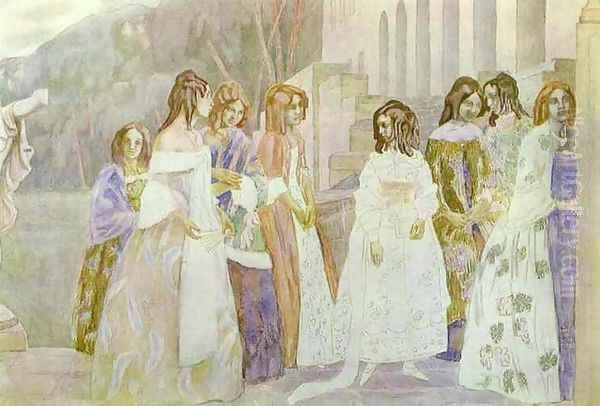
Viktor Borisov-Musatov's art is a testament to the power of dreams and the allure of memory. In his luminous, melancholic canvases, he captured the soul of an era, a wistful farewell to a world of aristocratic elegance and quiet contemplation. His unique blend of Symbolism, Post-Impressionism, and Art Nouveau aesthetics, filtered through a deeply personal and poetic sensibility, created a body of work that continues to enchant and move viewers. Though his life was cut short, his artistic legacy endures, marking him as one of the most original and evocative painters of Russia's Silver Age, a creator of "music for the eyes" whose gentle visions still resonate with a timeless beauty.